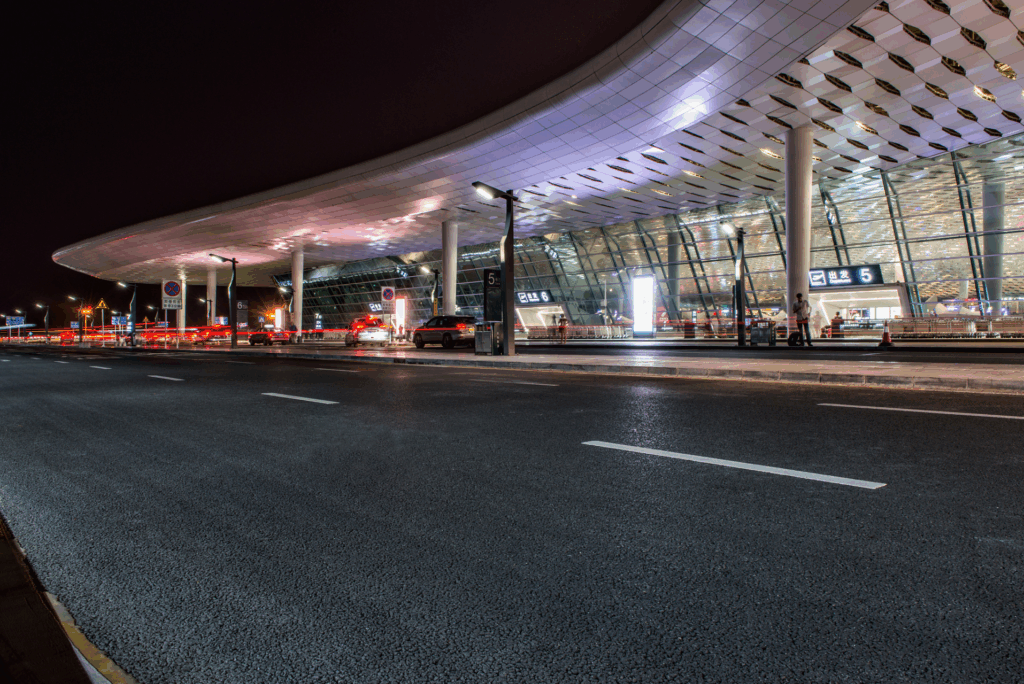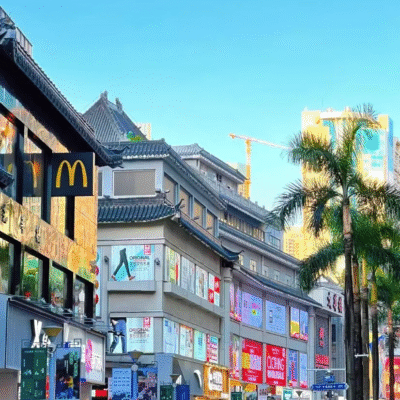Shenzhen is one of the busiest port cities in China, boasting 15 major ports of entry open to the outside world. These ports span various modes of transportation, including air, rail, road, and sea, and play a critical role in facilitating the international movement of travelers and goods.
This article provides a comprehensive overview of these 15 ports, detailing their categories, applicable visa policies, operating hours, transportation access, and customs clearance efficiency.
I. Airport Port of Entry
1. Shenzhen Bao’an International Airport
Shenzhen Bao’an International Airport is the city’s sole airport port of entry and one of China’s top four busiest airports. It handles over 40 million passengers annually and features three modern terminals equipped with advanced customs, immigration, and security facilities to ensure fast clearance.

The airport operates numerous international routes connecting major cities such as Osaka, Seoul, Bangkok, Singapore, and Los Angeles, greatly facilitating both business and leisure travel.
Additionally, the nearby Fuyong Port offers high-speed ferry services to and from Hong Kong and Macau, providing travelers with diverse cross-border transportation options. Bao’an Airport plays a pivotal role in driving international exchange and trade within Shenzhen and the entire Greater Bay Area.
- Visa Policy: Supports 5-day Visa on Arrival (VOA), 144-hour transit visa exemption, and regular visas to accommodate different traveler types.
- Operating Hours: Open 24 hours to accommodate flights at all times of day.
- Average Clearance Time: Thanks to advanced facilities and sufficient staffing, immigration clearance typically takes between 10 to 15 minutes, ensuring swift passenger processing.
- Transportation: Well connected to the city via Shenzhen Metro Line 1 and Line 11, as well as airport shuttle buses (A2 to A10) and multiple bus routes (such as M387, M527), offering passengers flexible travel options.
II. Railway Port of Entry
2. West Kowloon Railway Station
Located in Hong Kong’s Kowloon West district, West Kowloon Station is a major high-speed rail hub and the terminus of the Guangzhou-Shenzhen-Hong Kong Express Rail Link (XRL).
The station features a streamlined “co-location” arrangement allowing passengers to complete Hong Kong exit and Shenzhen entry immigration formalities in a single location, significantly reducing cross-border clearance times.
Travel time from West Kowloon to Shenzhen’s Futian or Shenzhen North Stations is approximately 15 to 20 minutes, greatly enhancing commuting efficiency between the two cities.
The station is equipped with advanced immigration facilities and offers comfortable waiting areas, supporting tens of thousands of travelers during peak periods.
- Visa Policy: Passengers must hold a valid standard visa to enter Shenzhen through this port.
- Operating Hours: Open daily from 06:30 to 23:30, covering most peak travel hours.
- Average Clearance Time: Thanks to the efficient “one-stop” immigration process and state-of-the-art equipment, average clearance times range from 10 to 15 minutes.
- Transportation Connections: West Kowloon Station is integrated with Hong Kong’s MTR network, including the East Rail Line and Airport Express, providing easy access to urban areas and the airport. On the Shenzhen side, Futian and Shenzhen North Stations connect to multiple metro lines (Lines 2, 3, 4, and 5), facilitating convenient travel to key districts.
III. Highway Ports of Entry (6 Ports)
3. Luohu Port
As Shenzhen’s oldest and busiest highway port, Luohu Port sits across the river from Hong Kong’s New Territories. It handles massive daily commuter traffic between Shenzhen and Hong Kong, making it a critical border crossing for workers and travelers.
- Visa Policy: Supports 5-day Visa on Arrival (VOA) and regular visas.
- Operating Hours: 06:30 to 24:00 daily.
- Average Clearance Time: Varies by time but generally efficient due to multiple lanes and staffing.
- Transportation: Direct access via Shenzhen Metro Line 1; Hong Kong MTR East Rail Line connects to Hung Hom station in Kowloon.
4. Wenjindu Port
Located east of Luohu, Wenjindu Port primarily functions as a key entry point for fruit imports into Shenzhen, playing a vital role in the city’s fresh produce supply chain.
- Visa Policy: Requires regular visas.
- Operating Hours: 07:00 to 22:00.
- Average Clearance Time: Approximately 5 minutes, due to streamlined customs processes.
- Transportation: Accessible by Shenzhen Metro Line 9 and bus routes 2, 5, and M468.
5. Huanggang Port
Huanggang is Shenzhen’s only 24-hour highway port of entry and is the largest land port for passenger and cargo clearance in China. It handles a high volume of commercial goods alongside travelers.
- Visa Policy: Supports 5-day VOA and regular visas.
- Operating Hours: 24 hours.
- Transportation: Connected via Shenzhen Metro Line 7 and bus routes 23, 326, etc. There are also direct bus services to Hong Kong Disneyland and Hong Kong International Airport, providing convenience for tourists and business travelers.
6. Futian Port
Adjacent to Huanggang, Futian Port links directly to Hong Kong’s Lok Ma Chau station. It features modern customs and immigration facilities designed to handle up to 250,000 crossings daily, making it one of the busiest and most advanced ports.
- Visa Policy: Requires regular visas.
- Operating Hours: 06:30 to 22:30.
- Transportation: Served by Shenzhen Metro Lines 4 and 10; connected to Hong Kong MTR East Rail Line.
7. Shatoujiao Port
Serving Shenzhen’s eastern districts of Yantian and Longgang, Shatoujiao Port accommodates both passenger and cargo traffic, balancing commercial and local commuter needs.
- Visa Policy: Requires regular visas.
- Operating Hours: 07:00 to 22:00.
- Average Clearance Time: About 5 minutes on average, supported by efficient staffing and customs infrastructure.
- Transportation: Accessible by buses 68, 358, B619.
8. Shenzhen Bay Port
Featuring 77 automated lanes and 53 manual lanes, Shenzhen Bay Port offers highly efficient customs clearance. It connects Shenzhen to Hong Kong’s New Territories, including the Tuen Mun area.
- Visa Policy: Requires regular visas.
- Operating Hours: 06:30 to 24:00.
- Transportation: Accessible via bus routes B2, B3, and dedicated Shenzhen Bay holiday shuttle services.
IV. Waterway Ports of Entry (7 Ports)
9. Shekou Port
Shekou Port is a major passenger and cargo hub, serving as a key maritime gateway to Macau and Hong Kong. It also acts as the home port for the luxury cruise terminal at Prince Bay.
- Visa Policy: Supports 5-day VOA and regular visas.
- Operating Hours: Passenger services operate from 07:00 to 22:30; cargo operations run 24 hours.
- Average Clearance Time: Typically 10 to 20 minutes depending on passenger volumes.
- Transportation: Served by Shenzhen Metro Line 2 and buses B601 and M105.
10. Yantian Port (Cargo Only)
Located in the Dapeng Bay area, Yantian Port is one of China’s four major deep-water container ports. It features intense international shipping activity, with over 80 weekly international routes, primarily focused on cargo.
- Operating Hours: Open 24 hours.
- Transportation: Accessible by bus routes 68, 85, 308, among others.
11. Chiwan Port (Cargo Only)
Chiwan Port, located in the western part of Shenzhen, is the city’s second-largest port after Yantian. It serves as a comprehensive transportation hub integrating maritime, road, and rail logistics, enabling seamless multimodal freight handling.

The port is specialized in bulk cargo operations, including containers, bulk raw materials, and heavy machinery. Equipped with advanced cargo handling equipment and extensive warehousing facilities, Chiwan Port efficiently manages high cargo throughput and supports the region’s industrial and manufacturing sectors. Its strategic location near key industrial zones and connection to inland railways enhances the speed and cost-effectiveness of goods transport, making it a vital gateway for import and export activities in South China.
12. Mawan Port (Cargo Only)
Mawan Port, located in the western region of the Pearl River Delta, serves as a vital multifunctional cargo hub catering to the diverse logistics needs of the area.

The port is equipped with state-of-the-art infrastructure, including deep-water berths, modern container handling equipment, and extensive warehousing facilities, enabling it to efficiently process a wide range of cargo types such as bulk commodities, containers, and heavy machinery.
Its strategic location provides seamless connectivity to major industrial zones and transportation networks, including highways and railways, facilitating swift inland distribution. Mawan Port plays a crucial role in supporting the manufacturing and export activities of the Pearl River Delta region, making it an indispensable asset in southern China’s maritime logistics chain.
13. Dachan Bay Port (Cargo Only)
Dachan Bay Port is a major container-specialized deep-water port located in western Shenzhen near the Pearl River Estuary.

Equipped with advanced automated terminal facilities and intelligent logistics systems, it efficiently handles ultra-large container ships. With well-developed rail and road connections, the port supports seamless sea-rail and road-rail intermodal transport, greatly enhancing cargo flow efficiency and reducing transportation costs.
The port actively promotes green and low-carbon technologies, aiming for environmental protection and sustainable development. Positioned as a key node in the Belt and Road Initiative, Dachan Bay continues to expand international shipping routes and strengthen its role in the global supply chain. With ongoing smart technology upgrades, it is set to lead innovation in the port industry.
14. Daya Bay Port (Cargo Only)
Situated along Shenzhen’s eastern coastline, Daya Bay Port services nearby energy and industrial parks, focusing on raw materials importation.
15. Meisha Port (Cargo Only)
A smaller port primarily serving the logistics demands of Yantian District, Meisha Port handles specialized cargo operations supporting regional industries.
Conclusion
Shenzhen’s 15 ports of entry highlight its role as a key international transportation hub.
For travelers, knowing the visa requirements and transportation options at each port can save time and reduce hassle. For businesses, the well-equipped ports ensure fast and reliable cargo movement, supporting Shenzhen’s position as a major trade center.






